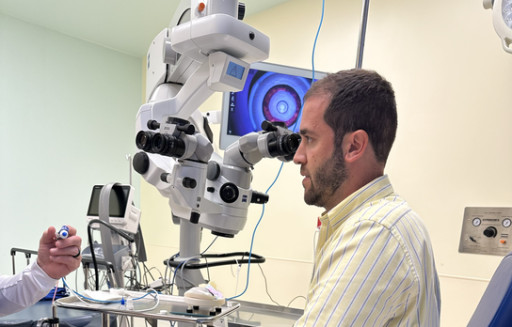All Categories
Featured
Low vision, a condition where traditional glasses, call lenses, or surgery can not completely restore view, can make daily tasks challenging. Low vision recovery offers an array of resources to assist people preserve their self-reliance and quality of life. This post explores the alternatives available for those looking for support in managing their aesthetic problems.
What Is Low Vision Rehabilitation?
Reduced vision rehabilitation is an organized strategy to help people optimize their remaining vision and adjust to new means of doing day-to-day tasks. Specialists collaborate with clients to create customized techniques, including tools, techniques, and training programs that suit their distinct requirements.
![]()
Key Options for Low Vision Recovery
Vision Enhancing Gadget
Optical Aids: Instruments like magnifiers, telescopic glasses, and special analysis lenses can enhance clearness for analysis, writing, and various other close-up activities.
Digital Visual Aids: Tools such as electronic magnifiers and portable video magnifiers provide flexible zoom capacities for various jobs.
Wearable Innovation: Smart glasses outfitted with video cameras and voice feedback offer sophisticated solutions for improving vision.
![]()
Assistive Technology
Screen visitors, text-to-speech applications, and gadgets with voice commands make innovation accessible for people with low vision.
Smartphone applications, such as navigation help and things acknowledgment tools, aid individuals interact with their environments more efficiently.
Training and Treatment
Positioning and Mobility Training: Professionals educate abilities for navigating areas securely, consisting of the use of white walking sticks or guide dogs.
Daily Living Skills Educating: Rehabilitation programs give strategies for food preparation, cleaning, and personal treatment, making certain that individuals can perform important jobs individually.
Aesthetic Abilities Training: Workouts designed to enhance using continuing to be peripheral vision can improve aesthetic functionality.
Ecological Adjustments
Changes to living or work spaces can dramatically enhance ease of access. Examples include:
Installing brighter lights.
Including high-contrast markings to appliances.
Organizing furniture to produce clear pathways.
Assistance Networks
Emotional and psychological assistance is a crucial component of recovery. Support system, therapy sessions, and counseling solutions can help individuals manage the difficulties of vision loss.
![]()
Peer networks connect people with similar experiences, promoting a sense of neighborhood and shared understanding.
Just How to Accessibility Reduced Vision Rehab Services
Low vision rehab solutions are often offered by:
Reduced Vision Clinics: Operated by optometrists and eye doctors specializing in vision problems.
Physical Therapists: Specialists in adapting jobs and settings to suit private requirements.
Not-for-profit Organizations: Groups such as the American Foundation for the Blind (AFB) or local blindness assistance organizations offer valuable sources and references.
Final Thought
Reduced vision rehab offers an array of resources customized to boost performance, increase confidence, and enhance quality of life. If you or a loved one is dealing with the difficulties of reduced vision, think about getting to out to a specialist or rehabilitation center to explore the several options offered.
What Is Low Vision Rehabilitation?
Reduced vision rehabilitation is an organized strategy to help people optimize their remaining vision and adjust to new means of doing day-to-day tasks. Specialists collaborate with clients to create customized techniques, including tools, techniques, and training programs that suit their distinct requirements.

Key Options for Low Vision Recovery
Vision Enhancing Gadget
Optical Aids: Instruments like magnifiers, telescopic glasses, and special analysis lenses can enhance clearness for analysis, writing, and various other close-up activities.
Digital Visual Aids: Tools such as electronic magnifiers and portable video magnifiers provide flexible zoom capacities for various jobs.
Wearable Innovation: Smart glasses outfitted with video cameras and voice feedback offer sophisticated solutions for improving vision.

Assistive Technology
Screen visitors, text-to-speech applications, and gadgets with voice commands make innovation accessible for people with low vision.
Smartphone applications, such as navigation help and things acknowledgment tools, aid individuals interact with their environments more efficiently.
Training and Treatment
Positioning and Mobility Training: Professionals educate abilities for navigating areas securely, consisting of the use of white walking sticks or guide dogs.
Daily Living Skills Educating: Rehabilitation programs give strategies for food preparation, cleaning, and personal treatment, making certain that individuals can perform important jobs individually.
Aesthetic Abilities Training: Workouts designed to enhance using continuing to be peripheral vision can improve aesthetic functionality.
Ecological Adjustments
Changes to living or work spaces can dramatically enhance ease of access. Examples include:
Installing brighter lights.
Including high-contrast markings to appliances.
Organizing furniture to produce clear pathways.
Assistance Networks
Emotional and psychological assistance is a crucial component of recovery. Support system, therapy sessions, and counseling solutions can help individuals manage the difficulties of vision loss.

Peer networks connect people with similar experiences, promoting a sense of neighborhood and shared understanding.
Just How to Accessibility Reduced Vision Rehab Services
Low vision rehab solutions are often offered by:
Reduced Vision Clinics: Operated by optometrists and eye doctors specializing in vision problems.
Physical Therapists: Specialists in adapting jobs and settings to suit private requirements.
Not-for-profit Organizations: Groups such as the American Foundation for the Blind (AFB) or local blindness assistance organizations offer valuable sources and references.
Final Thought
Reduced vision rehab offers an array of resources customized to boost performance, increase confidence, and enhance quality of life. If you or a loved one is dealing with the difficulties of reduced vision, think about getting to out to a specialist or rehabilitation center to explore the several options offered.
Latest Posts
Explore Affordable Auto Repairs with Montclare’s Monthly Service Specials
Published May 24, 25
1 min read
Uncover Brake Repair & More: Comprehensive Auto Care Solutions from Montclare Auto Repair
Published May 23, 25
1 min read
Shield and Improve Your Home with Weathercraft's Exterior siding Solutions
Published May 22, 25
1 min read
More
Latest Posts
Explore Affordable Auto Repairs with Montclare’s Monthly Service Specials
Published May 24, 25
1 min read
Uncover Brake Repair & More: Comprehensive Auto Care Solutions from Montclare Auto Repair
Published May 23, 25
1 min read
Shield and Improve Your Home with Weathercraft's Exterior siding Solutions
Published May 22, 25
1 min read